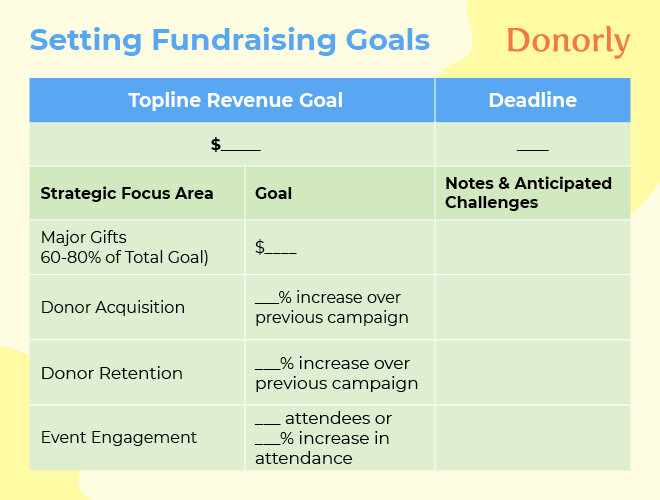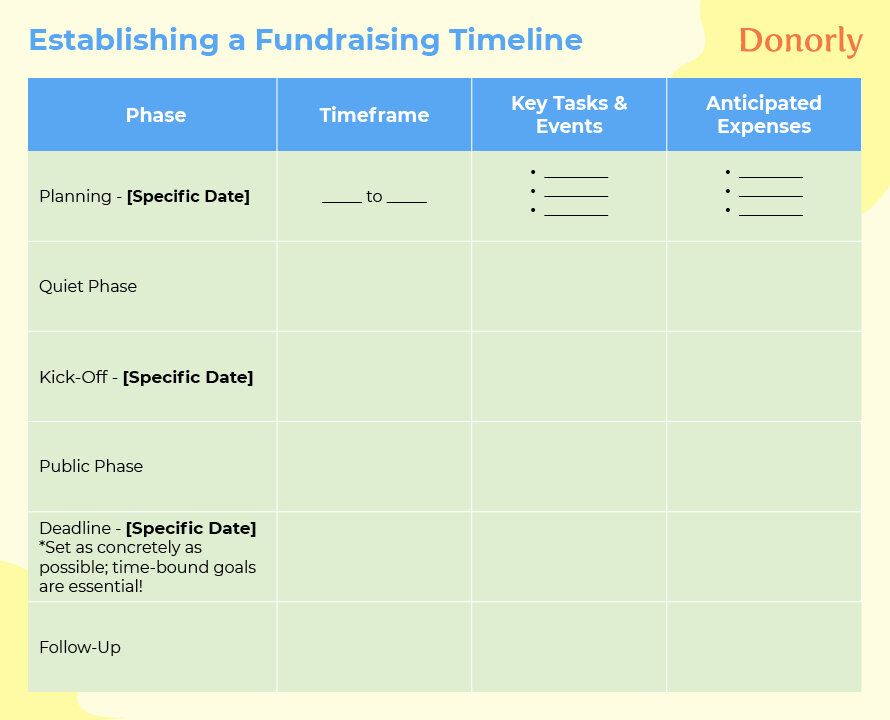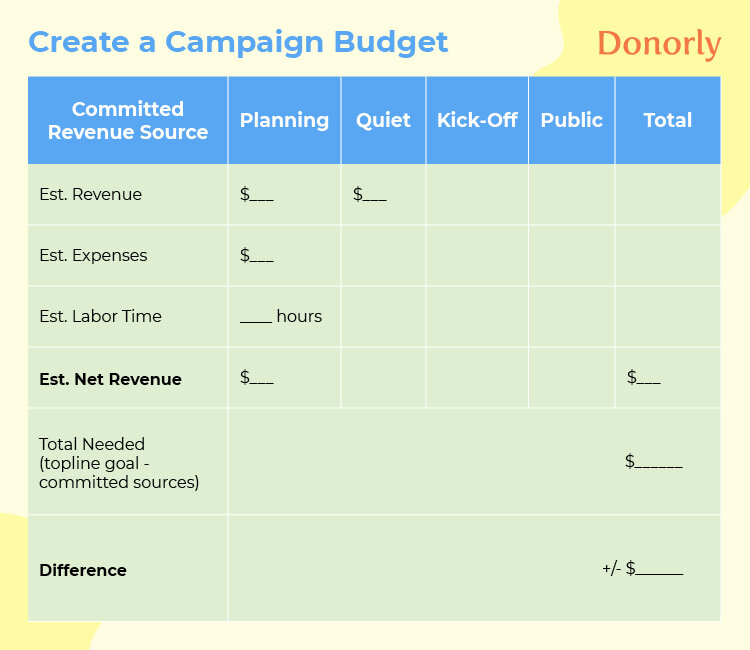

Successful fundraising takes a lot of work. Especially if you’re running a long-term, complex campaign, it’s crucial to have a carefully outlined fundraising plan to keep your team on track to meet your goals.
Planning, launching, and executing strategic fundraising campaigns plays a critical role in scaling up your nonprofit’s work in sustainable ways, and the Donorly team is proud to have helped countless organizations do just that. This fundraising plan template sums up our team’s years of expertise on the frontlines of fundraising.
Here’s what we’ll cover:
Ready to start planning your best campaign yet? Let’s dive in.

This comprehensive fundraising plan template walks through all of the strategic essentials for a successful campaign.
The specific examples outlined in the template are most immediately relevant to capital campaigns or other major development initiatives. However, the entire template can easily be adapted for other contexts, including annual fundraising, ad hoc campaigns, and general planning purposes. Structure your own strategy and planning process with the core steps outlined in this template:


Simply put, a fundraising plan outlines all the tasks your nonprofit needs to accomplish in order to run a successful campaign. These include setting goals, identifying target donors, developing outreach tactics, and more.
Since nonprofits’ goals will vary drastically based on a wide range of factors, fundraising campaigns naturally come in all shapes and sizes. However, as professional fundraisers will tell you, a concrete fundraising plan or roadmap is the common denominator across all successful campaigns.
We understand that not every nonprofit has the resources on-hand to create comprehensive fundraising plans from scratch. That’s where a template comes in! By filling in your fundraising plan template and following the steps outlined below, your team will be able to create a detailed roadmap to keep the campaign on track from start to finish.
Let’s dig into each step of the fundraising plan template in greater detail:
Your fundraising campaign’s goals should guide every element of your strategy. Without concrete goals, you’ll be unable to course-correct over time or even accurately gauge your success once the campaign ends. Begin filling out the fundraising plan template by setting the following goals:

This step in the fundraising plan template is all about laying the foundation for your strategy. Your central revenue goal and the separate factors that comprise it will (and should) impact all of the decisions you make and specific tactics you use during the campaign. You’ll just need to ensure that this foundation is strong by setting SMART goals:

As mentioned above, it’s highly recommended that nonprofits planning capital campaigns conduct a feasibility study very early in the process. These studies are conducted by third-party experts (like the Donorly team) who analyze your past campaigns and interview your nonprofit’s key stakeholders to determine their perception of your organization and your campaign’s goals. These insights will help you understand whether you can feasibly reach those goals right now or if your time would be better spent focusing on other ways to build your fundraising capacity. Since capital campaigns are major multi-year investments of time and resources, understanding their feasibility as early as possible is a smart move to take during this first stage of planning a campaign.
Next, determine specific start and end dates for your fundraising campaign. Without a concrete timeframe to work within, it becomes much easier for your strategy to lose focus or direction over time.
It should be fairly easy to set a start date for the first stage of your campaign, but setting a deadline might be more difficult. Remember that time-bound goals are essential. At this early stage, your deadline might not be a specific date but instead a more general period like “Mid June.” You’ll need to eventually set a specific deadline as your campaign strategy and timeline come into focus, but the main idea is to be as concrete as possible with the guidelines you set at each step in the planning process.
Once you’ve determined a start date and end date as specifically as possible, begin filling in a rough timeline broken down by campaign phases or stages. Capital campaigns and other major development campaigns consist of these core stages:
Following a clear structure of planning, soliciting major donors and stakeholders, publicly kicking off your campaign, and then broadening your marketing to a wider audience of supporters is a reliable way to keep any campaign focused and your tasks prioritized. If you’re planning a different type of fundraising campaign, the exact phases that make up your plan might vary, so adjust your own approach as needed based on this core structure.
Break down your campaign by these phases and set timeframes for each based on your start and end dates:

For each phase, go ahead and outline the key tasks, events, and anticipated expenses that you can already take into account. For example, if you already know that you’ll conduct a feasibility study early in the process, plan ahead to include it (and the cost of conducting it) in the planning phase. Plan ahead to conduct ongoing prospect research and use prospecting tools during the quiet phase. If you know that you’ll host a kick-off event and will need to invest in new virtual event software, those are also important points to know in advance.
Try to be as thorough as possible at this step. Knowing what needs to be accomplished and accounted for in each phase will be extremely helpful as you complete the rest of your fundraising plan template. Plus, including more details (rather than fewer) that you can refine over time will ultimately result in a much more useful fundraising strategy that’s easier to execute.
Next, begin outlining a budget for your fundraising campaign and all of its associated tasks that you’ve already identified.
Whenever possible, anchor your budget with insights from previous campaigns and events. If you’ve hosted events or planned campaigns similar to the one you’re planning now, data on how those earlier strategies performed will be invaluable. For example, the performance of last year’s annual campaign should be the first place you look when developing a budget that will be realistic and supportive of your goals for your next annual campaign. If you have past campaigns or events to study, break down their performance like this:

This exercise should give you a detailed view of how past campaigns or events performed in order to guide the budgeting process for your new campaign. Break down each campaign or event’s expenses, total revenue, and net revenue by source, and see how they stacked up against your goals for that campaign or event. If you know how much labor time went into each entry in your list, or any additional relevant notes, record them too.
Next, regardless of whether you had previous campaigns to study, outline your current committed sources that will contribute to your new campaign:

This step will look different for every campaign, but the main idea is to record and fully account for any relevant committed sources early in the process. For instance, previous pledges from major donors, government grants, and grants from private foundations are all common committed sources for capital campaigns. Make note of any important restrictions or compliance needs that you’ll need to keep in mind to actually use that committed funding. Tally how much you already have committed for your campaign, and subtract that from your campaign’s topline revenue goal. This will give you the total needed that you should plan to raise across the duration of your campaign.
Next, combine these budgeting insights and the notes you made while creating a rough timeline in Step 2. Your general campaign budget might look like this:

This fundraising campaign budget template includes all of the essentials—estimated revenue, expenses, and labor time—for each phase of the campaign. Use insights from a number of sources to fill in each estimate in your own budget. These sources can include:
Once you’ve filled in your budget estimates, calculate the estimated net revenue by phase and in total. Then refer back to the total amount needed that you determined earlier (your topline goal minus your total committed sources). The difference between your total net revenue and total needed will give you a sense of how accurately you’ve projected your campaign budget. In a perfect world, the difference between these numbers will be zero. However, it’s more than likely that you’ll find some difference, meaning you’ll need to continue refining your plans in each stage by trimming expenses or planning to raise more.
The main purpose of this step in the fundraising plan template is to give yourself a concrete idea of how much you’ll expect to spend, how much you want to raise, and how those two numbers relate at each campaign stage and as a whole. Having a solid budget in place early will also be critical once it’s time to advocate for your campaign plans and secure buy-in from your board.
As your budget and strategy continue coming into focus, adjust your plans with your budget and goals in mind. Just be sure to account for any new expenses that result from these changes. For example, if you find that you’ll want to boost revenue by reaching out to donors via direct mail during the public phase, don’t forget to add the printing and mailing costs to your expenses for that phase. If a donor recognition wall will play a part in your post-campaign stewardship strategy, account for its cost now so that you can plan to raise enough to cover it.
Now it’s time to begin bringing all of it together. Based on your goals, timeline, and budget estimates, fill out a thorough calendar for your fundraising campaign. This comprehensive resource should give your team a complete view of how every strategic element fits together, and it will serve as a guiding document to keep your efforts focused from start to finish. Here’s what we recommend including:

This fundraising calendar template breaks out key information for each phase. For instance, the quiet phase includes its date, a list of specific activities that will be accomplished during that phase, and the budget estimates worked out in Step 3. Calculate the totals for each category at the bottom for a birds-eye view of how the logistics of your campaign are shaping up.
As with the previous steps in this fundraising template, your exact strategies and projections will continue to evolve over time as needed. Finalizing a comprehensive calendar like this one before your campaign launches will keep your strategies focused on the essentials no matter what changes you make down the line. Anchoring your calendar with your goals and budget will keep these keystone elements front and center.
With your goals, budget, and timeline coming into focus, it’s time to dig deeper into the gifts that will make the most difference. A gift pyramid (also called a gift range chart or gift table) is a document that outlines how many major gifts you’ll need at different levels in order to reach your campaign’s goals.
Remember, for a capital campaign, the amount raised through major gifts should be around 60-80% of your campaign’s total revenue goal. The exact proportion that you aim for will vary based on a number of factors. If you’ve worked with a fundraising consultant to conduct your feasibility study, they should be able to guide you in the right direction to set appropriate major fundraising goals based on your nonprofit’s current fundraising capacity.
Once you’ve determined how much you’ll raise through major gifts, begin breaking them down by number and amount. Here’s a sample gift range chart with example values filled in:

In this example, the organization subtracted its committed sources from its topline revenue goal to determine the total needed: $1,250,000. Then, they determined the amount of that total (in this case 80%) that will be raised through major gifts: $1,000,000. Next, the organization broke its million-dollar major fundraising goal down into specific tiers, starting with a single major gift in the largest tier and followed by increasing numbers of smaller individual gifts.
These tiers and the definition of “major gifts” will vary for every organization based on budget considerations, donor behavior and more, so think carefully about what realistic tiers will look like for your own organization. Just remember this pro fundraising tip: the highest gift in your gift pyramid should make up roughly 10-20% of the total amount you’re planning to raise through major gifts.
Larger gifts naturally take more time to identify, cultivate, and solicit, so breaking your approach down into a pyramid of tiers is an extremely useful way to make the process as efficient as possible. For instance, a single development officer might need to personally tackle securing the largest gift from a small pool of prospects, while a larger team would be able to share the work of securing dozens of smaller gifts from a much larger segment of mid-range donors. Your gift range chart will be an invaluable resource for your team over the duration of your campaign, so it pays to invest time and attention into developing it. Plus, these concrete numbers and amounts will give you quantified benchmarks to use during the campaign in order to gauge your progress and shift attention as needed.

During this final ongoing step, keep filling in the blanks and refining your strategies and budget estimates in your campaign calendar. As you finalize your plans and secure buy-in, there will likely be some back-and-forth among your organization’s leadership. Be sure to accurately adjust any relevant documents over time as your campaign’s strategic elements come into sharper focus.
Then, delegate specific tasks to your team members. Having clearly defined roles and responsibilities early will keep your campaign focused and allow individuals to get a head start on brainstorming and preparing. Additionally, if you haven’t yet hired a fundraising consultant or prospect researcher, now is a good time to do so. An outside expert can be an invaluable partner for:
The Donorly team provides custom guidance for all of these key elements and specializes in helping growing nonprofits lay out the strategies they need to raise more and connect with the game-changing donors who help them scale up their operations. With customized fundraising consulting for complete campaign support and hourly prospect research services, our experts take the guesswork out of fundraising so you can focus on your mission. Reach out to learn more.
Congratulations! You’ve tackled all of the critical essentials in a complete fundraising plan template! Laying a concrete foundation for your campaign and backing it up with solid data and estimates is hard work, but it’s essential for keeping your plans focused, achievable, and ultimately successful.
For custom guidance on any of the steps in this template or what to do once you’ve completed it, Donorly is here to help. Or, if you’re just getting started and want to keep exploring, we recommend these additional resources: